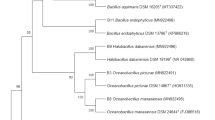Abstract
Biochemical and physiological characteristics of salt-tolerant (88 mM, 264 mM and 440 mM NaCl) strains of Bradyrhizobium were evaluated according to their capacity for using different carbon sources, growth rate, resistance to antibiotics, plasmid profile and exopolysaccharide production. Salt-tolerant strains significantly enhance their capacity to oxidize C sources (about 75–85 compounds) by increasing growth rate and exopolysaccharide production involved in adhesion, resulting in a greater adapting capacity to colonize unfavorable saline environments. However, salt stress could work as a curing agent and thus the gene stability would become critical for the biological nitrogen-fixation information present in plasmids, as is the case in Rhizobium.
Similar content being viewed by others
Author information
Authors and Affiliations
Additional information
Received: 5 January 1998
Rights and permissions
About this article
Cite this article
Barboza, F., Correa, N. & Rosas, S. Metabolic and physiological characteristics of salt-tolerant strains of Bradyrhizobium spp.. Biol Fertil Soils 32, 368–373 (2000). https://doi.org/10.1007/s003740000261
Issue Date:
DOI: https://doi.org/10.1007/s003740000261




